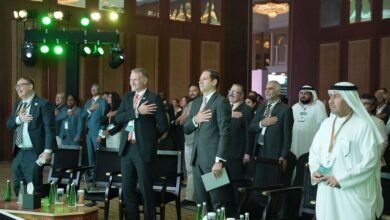
Zero-Waste Wonders: UAE’s Pioneering Efforts in Sustainable Construction
The UAE’s construction industry is pioneering a shift towards green architecture, integrating renewable energy sources and sustainable design principles to reduce carbon footprint and enhance energy efficiency. This approach has seen a surge in the use of recycled materials and low-VOC products, spotlighting the UAE’s commitment to sustainable architecture and environmental impact mitigation.
Exploring how traditional practices align with modern green architecture principles, this article delves into the significance of biophilic design, green roofs, and climate control in creating energy-efficient and socially sustainable buildings. Innovations in renewable energy and smart building technologies underscore the UAE’s role as a leader in decarbonization and waste reduction, shaping a future where architecture harmonizes with the environment.
The Influence of UAE’s Natural Landscape on Architectural Design
The architectural landscape of the UAE is deeply intertwined with its natural environment, reflecting a heritage that has mastered the art of adapting to the arid desert conditions. Traditional structures, notably influenced by the harsh climate and Indigenous culture, utilized materials and designs that were not only sustainable but also ideally suited to the local conditions.
Traditional Materials and Techniques
- Palm Frond Shelters: Known as arish, these were used during the hotter months, providing lightweight, air-permeable shelter.
- Animal Skin Shelters: In colder months, Bait al Sha’ar made from animal skins offered more substantial protection against the cooler desert nights.
- Seashells and Limestone: These materials were commonly used in construction from the late 19th to early 20th centuries, leveraging their natural abundance and thermal properties.
Architectural Features for Climate Adaptation
- Wind Towers (Barjeel): These traditional ventilation structures exemplify how ancient builders incorporated natural cooling systems into their designs.
- Courtyard Layouts: Central courtyards served as a communal area that maximized shade and airflow throughout the surrounding structures.
- Geometric Patterns and Natural Materials: Intricate designs not only added aesthetic value but also functional elements that enhanced privacy and controlled light.
Modern Sustainable Practices
- Rooftop and Vertical Gardens: Addressing space constraints in urban areas, these green spaces help reduce the urban heat island effect and improve air quality.
- Eco-friendly Hardscaping: Utilizing recycled and permeable materials minimizes environmental impact and supports efficient water drainage.
- Water Conservation Features: Modern designs incorporate features like recirculating fountains and rainwater harvesting systems to optimize water use.
These traditional and modern practices illustrate a seamless blend of form, function, and sustainability, driven by the UAE’s unique landscape and cultural heritage. This integration not only preserves the environment but also enhances the social and aesthetic appeal of urban spaces, fostering a sense of community and belonging.
Cultural and Historical Influence on Sustainable Practices
Traditional and Sustainable Architectural Practices
The architectural ethos of the UAE deeply intertwines with its cultural and historical roots, leveraging local and sustainable materials that not only provide a robust framework for modern needs but also align with traditional social contexts. This approach significantly reduces energy consumption, fostering environments that are both functional and culturally resonant.
Integration of Cultural Growth in Architecture
Since the early 2000s, the UAE has seen a dynamic expansion in its cultural sectors, propelled by governmental efforts towards economic diversification. This cultural renaissance has not only enhanced public interest and investment in cultural infrastructures but has also encouraged a new generation of Emiratis to explore creative domains. These ventures are vividly reflected in architecture, where traditional elements are harmoniously blended with modern design principles.
Emirati Design on the Global Stage
Displaying its rich heritage and innovative future, the UAE has actively participated in international platforms like Milan Design Week and the Venice Biennale. These events highlight the unique Emirati design ethos that respects traditional practices while embracing contemporary trends, promoting a global cultural exchange that enriches sustainable architectural practices.
Preserving Cultural and Architectural Heritage
The commitment to preserving the UAE’s cultural heritage extends beyond maintaining physical sites to encompassing a broader spectrum that includes safeguarding intangible cultural memories and social processes. This integrated approach ensures that the architectural developments remain deeply rooted in the Emirati identity while advancing towards sustainable innovation.
Strategic Cultural Partnerships for Sustainable Development
The UAE has forged significant cultural partnerships globally, aligning its cultural and architectural advancements with international sustainable goals. These collaborations foster a shared commitment to integrating cultural dimensions within sustainable development frameworks, highlighting the role of cultural understanding in achieving broader environmental goals.
Clay Architecture: A Testament to Sustainability and Culture
Emphasizing the sustainability of traditional materials, clay architecture in the UAE stands as a testament to the ingenuity of past generations. Modern architects are now revisiting these methods, applying them in contemporary contexts to create buildings that are not only environmentally friendly but also culturally significant. This resurgence of traditional techniques underscores a broader recognition of their value in present-day architectural practices.
Green Architecture and Urban Planning
In the UAE, green architecture and urban planning are pivotal in shaping sustainable cities. The Dubai Municipality’s strategic implementation of Green Building Regulations underscores a commitment to environmental protection while fostering economic growth. These regulations, applicable to all new and existing structures in Dubai, prioritize ecological considerations across construction, demolition, and operational phases, emphasizing energy and water efficiency and the health and welfare of occupants.
Key Regulations and Their Impact
- Enhanced Internal Environment: Focus on improving air quality and comfort inside buildings.
- Energy and Water Efficiency: Regulations enforce the use of energy-efficient appliances and water-saving fixtures.
- Material Usage: Encouragement of thermal and acoustical insulation materials, and management of hazardous substances.
The Green Building Practice Guide, a collaborative initiative between Dubai Municipality and Dubai Electricity and Water Authority, simplifies the adoption of green standards, ensuring safety and ease of application. This guide is crucial for developers and architects aiming to integrate sustainable practices into their projects.
Economic and Environmental Benefits
- Cost Reduction: Green buildings reduce energy costs by up to 30% through technologies like solar panels and advanced insulation.
- Increased Property Value: Such properties often attract higher rental and resale values due to their eco-friendly features.
By 2030, the UAE aims to construct 50% of new buildings according to green standards, significantly reducing greenhouse gas emissions and optimizing resource use. This ambitious goal highlights the UAE’s initiative-taking approach to minimizing its ecological footprint, which is notably high globally.
Leading by Example in Global Sustainability
- LEED-certified Projects: Over 550 projects in the UAE, placing it third globally for green-certified buildings.
- Innovative Urban Projects: Masdar City and Dubai’s Sustainable City are benchmarks in sustainable urban development, featuring renewable energy systems and zero-energy buildings.
The integration of smart technologies such as IoT in buildings and the emphasis on renewable energy projects like the Mohammed bin Rashid Al Maktoum Solar Park illustrate the UAE’s forward-thinking in sustainable urban planning. These initiatives not only support the environmental goals but also enhance the quality of urban life, making the UAE a global leader in sustainable development.
Innovative Materials and Technologies in UAE Architecture
In the realm of sustainable development, the UAE’s architecture sector is rapidly advancing through the integration of innovative materials and technologies. This section highlights some of the innovative materials and construction techniques that are setting new benchmarks in the industry.
Advanced Materials and Construction Techniques
- High-Performance Concrete (HPC): Known for its exceptional strength and durability, HPC is revolutionizing the UAE’s construction landscape, enabling structures to withstand harsh environmental conditions.
- Nanomaterials: These materials enhance the resilience and longevity of building components, playing a crucial role in modern construction projects.
- BioSand and Desert Cotton: Innovations like BioSand, developed using biopolymers from regional plants, and desert cotton for upholstery, display the potential of local resources in sustainable construction.
- 3D Printing in Architecture: The UAE has embraced 3D printing, evidenced by projects like the world’s first 3D-printed office building in Dubai, highlighting the efficiency and reduced waste associated with this technology.
- Robotic Technologies: The use of robotic smear application in projects like the Museum of the Future in Dubai illustrates the precision and efficiency brought by robotics in construction.
- Transparent Wood and Graphene: New materials like transparent wood, expected to be introduced in the UAE market, along with investments in graphene research, are anticipated to offer superior performance and sustainability.
Implementation Challenges
- Cost and Availability: The adoption of advanced materials is often hindered by higher costs and limited availability compared to traditional materials.
- Skill Requirements: There is a growing need to train the construction workforce to adeptly manage and integrate these new materials into existing practices.
- Retrofitting Challenges: Integrating modern technologies into existing buildings, especially heritage structures, requires meticulous planning and adaptation.
These innovative approaches not only reflect the UAE’s commitment to sustainable building practices but also its position as a leader in architectural innovation on the global stage. The continuous exploration and adoption of these materials and technologies are crucial for advancing towards a more sustainable and efficient architectural future.
Case Studies: Leading Sustainable Buildings in the UAE
Lattice-Domed Parliament Building, Abu Dhabi
This architectural marvel stands as a testament to sustainable design, featuring a lattice dome that not only provides shade but also maximizes natural light, reducing energy consumption significantly.
The Sustainable City, Dubai
Dubai’s first operational net zero energy community embodies green living. It features solar-powered homes, waste recycling, and a car-free lifestyle, setting a benchmark in sustainable urban development.
Pacific Controls Headquarters Building, Dubai
Recognized for its intelligent use of technology, this building integrates advanced automation systems to optimize energy and water usage, making it a model of efficiency.
Sheikh Khalifa Medical City, Abu Dhabi
This medical facility incorporates energy-efficient buildings and sustainable practices, focusing on patient well-being while minimizing environmental impact.
Siemens Headquarters, Abu Dhabi
As a LEED Platinum-certified building, Siemens Headquarters uses smart building technologies and sustainable materials, highlighting energy efficiency and reduced carbon footprint.
The Irena Building, Masdar, UAE
Located in Masdar City, this building is a hub for renewable energy research and development, highlighting innovative sustainable technologies and design principles.
Midfield Terminal, Abu Dhabi International Airport
The terminal features a design optimized for natural light and uses renewable energy sources, significantly enhancing passenger experience while reducing energy use.
Twin Al Bahr Towers, Abu Dhabi
These towers are renowned for their responsive façade that adjusts to the movement of the sun, significantly reducing heat gain and energy consumption.
The Aldar Market, Abu Dhabi
Aldar Market integrates traditional market designs with modern sustainable architecture, promoting local businesses while adhering to green building standards.
Modern Architectural Innovations in Dubai
Dubai’s skyline is dotted with structures like the Burj Khalifa and Emirates Towers, which reflect a blend of modern design and sustainable architecture practices, contributing to the city’s reputation as a leader in innovative building solutions.
Historical Context and Traditional Practices
Traditional Architecture and Urban Evolution
Social Dynamics and Architectural Development
Social factors have always played a pivotal role in shaping architectural practices in the UAE. The dynamic interplay between evolving societal needs and architectural responses has been evident since the earliest settlements, such as Al Ain, which utilized local resources to support its agricultural economy through trade via the port of Umm Al Nar.
Impact of Globalization and Wealth Influx
The discovery of oil in the late 1950s transformed the UAE from a region of modest settlements to a hub of global significance. This economic boom brought about a dramatic shift in architectural styles, from traditional mud-brick homes to towering skyscrapers. The influx of wealth and expatriates spurred a modernization wave, introducing concrete structures and high-rise buildings, fundamentally altering the urban landscape.
Traditional vs. Modern Architectural Elements
- Barjeel (Wind Towers): Originally designed for natural cooling in the harsh desert climate, these have been aesthetically adapted in modern constructions, often serving more decorative than functional purposes.
- Cultural Representation in Architecture: Today’s UAE cities display a mix of Islamic architectural influences alongside modern designs, reflecting a blend of tradition and contemporary aesthetics. In less commercialized areas, reconstructed traditional elements like barjeel structures are prevalent, though mainly ornamental.
Evolution of Urban Spaces
The transformation of urban areas in the UAE has been marked by the rise of skyscraper islands and luxury shopping malls, which have replaced older commercial districts. These developments feature modern interpretations of traditional designs, such as ornamental wind catchers and calligraphic art, which pay homage to the region’s architectural heritage while catering to contemporary tastes and lifestyles.
This blend of historical reverence and modern innovation continues to shape the UAE’s architectural identity, bridging its rich past with a forward-thinking present.
The journey through the United Arab Emirates’ architectural evolution displays a remarkable blend of traditional and modern sustainable practices. From leveraging ancient techniques such as wind towers and courtyard layouts to innovative applications in green roofs, biophilic design, and smart technologies, the UAE’s approach harmonizes cultural heritage with advanced sustainability goals. This seamless integration not only preserves the environment but also enhances urban livability, showcasing the UAE as a global leader in sustainable development and green architecture.
As the UAE continues to pioneer in merging traditional practices with green innovation, the implications for global architecture and urban planning are profound. The emphasis on sustainability, coupled with the commitment to cultural and environmental preservation, sets a precedent for future developments worldwide. Encouraging further research and innovation in sustainable materials and technologies, the UAE’s journey underscores the significant impact of thoughtful, green architectural approaches on society and the environment, inspiring a new generation of architects and planners to think sustainably.







[…] policy in the United States. Zeldin now becomes the pioneering force behind environmental regulation and policy implementation […]
[…] families created sophisticated preservation techniques before modern refrigeration existed. These methods preserved food and became a vital link to […]
[…] practices. Residents and visitors now follow the organizing committee’s complete eco-friendly initiatives to reduce waste, reuse decorations and celebrate […]
[…] life to becoming the nation’s founding father showed his passion for education, environmental conservation, women’s empowerment, and preserving culture. These values stem from Islamic […]
[…] serves as the life-blood of luxury real estate. UAE investors prioritize eco-friendly features with 80% showing strong interest. Energy-efficient homes sell for 25% more than […]